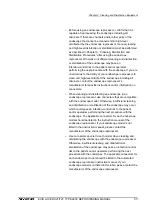
60
Chapter 3 Cleaning, Disinfection and Sterilization Procedures
EVIS LUCERA JF/TJF TYPE 260V REPROCESSING MANUAL
Rinsing after high-level disinfection
After high-level disinfection, rinse all equipment according to the procedures
described below.
Use water of appropriate microbiological quality. Once removed from disinfectant
solution, the instrument must be thoroughly rinsed with sterile water to remove
any disinfectant residue. If sterile water is not available, fresh potable tap water
or water which has been processed (e.g. filtered) to improve its microbiological
quality may be used with 70% ethyl or isopropyl alcohol rinse (see “Non-sterile
water rinse and alcohol flush” on page 61). Consult with your hospital’s infection
control committee.
Alcohol is flammable. Handle it with care.
Sterile water rinse
1.
Fill a small basin with sterile water. Use a basin which is deep enough to
allow all equipment to be completely immersed.
2.
Immerse all equipment in the sterile water.
3.
Gently agitate the equipment to thoroughly rinse them.
4.
Using the 30 cm
3
(30 ml) syringe, flush the interior and recessed parts of all
equipment with sterile water while they are immersed. Ensure that all air
bubbles are expelled.
5.
While immersed, depress and release the pistons of the air/water valve,
suction valve and AW channel cleaning adapter. Ensure that all air bubbles
are expelled.
6.
Rub the bristles of the channel cleaning brush and channel-opening
cleaning brush to remove all air bubbles.
7.
Attach the 30 cm
3
(30 ml) syringe to the suction cleaning adapter and flush
the adapter with 30 cm
3
(30 ml) of sterile water while it is immersed. Ensure
that all air bubbles are expelled.
8.
Remove the suction cleaning adapter from the sterile water. Hold the
adapter and tilt it to expel the sterile water remaining in the adapter.
9.
Using the 30 cm
3
(30 ml) syringe, flush air to dry the inside of the suction
cleaning adapter.
10.
Remove all equipment from the sterile water.
11.
Use a sterile, lint-free cloth to thoroughly wipe and dry all external surfaces.
















































